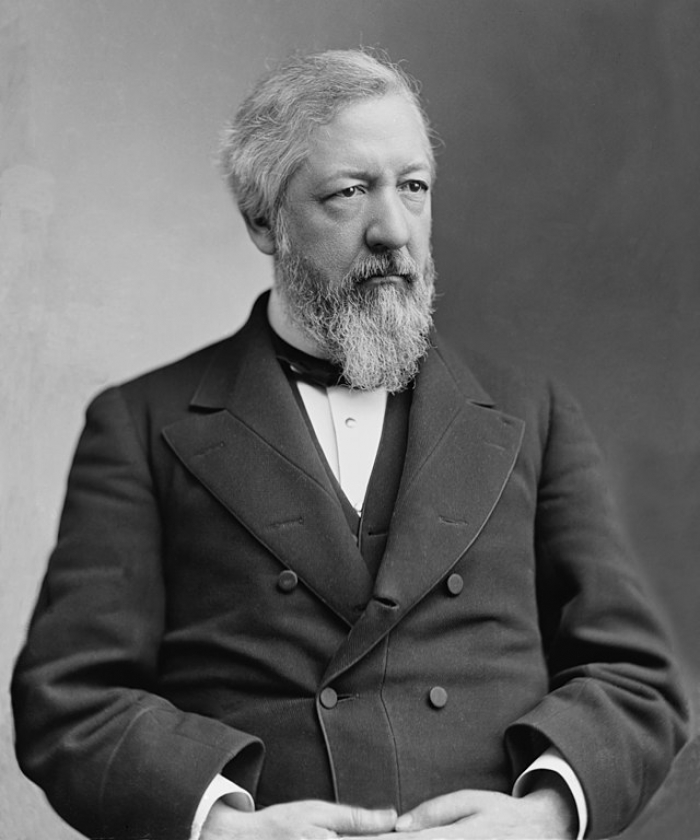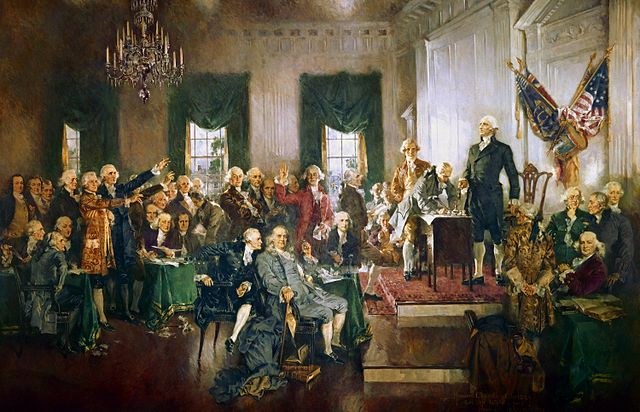Article 5 of the U.S. Constitution outlines the amending process by which the First Amendment, along with the other 26, was adopted and through which it could someday be expanded or modified.
Nine states needed to ratify new Constitution
The Articles of Confederation, the country’s governing document when the delegates to the Constitutional Convention of 1787 were meeting, required all the state legislatures to ratify amendments proposed by the national legislature. This process was so difficult that the states never managed to amend the Articles themselves. The Constitutional Convention ultimately overcame this problem by specifying that the new document would take effect among ratifying states when conventions in nine or more approved it.
Observing that the new constitution would require altering, Virginia’s George Mason suggested providing for amendment “in an easy, regular and Constitutional way” rather than leaving it to ”chance and violence” (Farrand 1966: 1:203).
Delegates created process to amend the U.S. Constitution
Delegates originally considered a plan whereby Congress would call a convention to propose amendments when it received petitions from two-thirds of the states. They modified this to allow not only for state-requested conventions — none have convened to date — but also for two-thirds majorities in both houses of Congress to propose amendments.
Such amendments become effective when ratified, according to congressional specification, either by three-fourths of the state legislatures or by conventions called within the states, as in the case of the Twenty-first Amendment, which repealed a national prohibition on alcohol. By requiring supermajorities, delegates hoped to establish amendments, like the Constitution itself, as paramount law.
The Constitution’s Article 5 contained two entrenchment clauses. One guarded the compromise allowing states to import slaves without penalty for a period of 20 years, and the other affirmed the critical Connecticut compromise by prohibiting states from being deprived of their equal representation in the U.S. Senate without their consent. From time to time, scholars have argued that some rights, such as those embodied in the First Amendment, might be so fundamental that they cannot be altered through the amending process, but no Supreme Court decision has ever been based on this theory.

Some lawmakers have proposed amendments that would change provisions in the First Amendment, such as the Blaine Amendment by House Speaker James G. Blaine in 1875 (pictured) that would have prohibited public support of parochial schools. But to date, no amendment altering the First Amendment’s provisions (or the Bill of Rights as a whole)has summoned enough support to pass. (Photo of James G. Blaine via Library of Congress, public domain)
Delegates rejected bill of rights in original Constitution
The original Constitution prohibited religious-test oaths for public officials, exempted Sundays from the days that a president had to return a bill, and protected members of Congress for words they uttered within that body, but the delegates rejected a proposal to protect freedom of the press or for a separate bill of rights.
The Anti-Federalists cited this as a reason for opposing the Constitution during ratification debates. Although leading Federalists initially argued that a bill of rights was unnecessary and could even prove dangerous, in time they eventually supported a bill of rights as a way of heading off the possibility of a second convention that might undo the work of the first.
James Madison led the drive in the First Congress that resulted in the adoption of the first ten amendments, the first of which addresses religion, speech, press, and peaceable assembly and petition.
Fourteenth Amendment applied First Amendment guarantees to the states
Madison had favored an amendment providing that “no State shall violate the equal rights of conscience, or the freedom of the press, or the trial by jury in criminal cases,” but it failed to make it through the First Congress (Kurland and Lerner 1987: 5:25).
In time, the Supreme Court used the Fourteenth Amendment to apply the guarantees in the First Amendment to the states as well as to Congress, and other changes in constitutional practice and interpretation altered the nation’s understandings of these provisions.
Movements to acknowledge authority of God in the Constitution
Some individuals concerned about the founders’ failure to mention God in the Constitution launched a movement in the early 1800s that has been revived several times since to make such an addition. Some of these proposals, such as one supported in the twentieth century by the National Association of Evangelicals, advocated specifically acknowledging the authority of Jesus Christ.
In 1875, House Speaker James G. Blaine of Maine introduced an amendment, named after him, that would have applied the religion clauses of the First Amendment to the states and prohibited public support of parochial schools.
Members of Congress have similarly introduced amendments that would reverse the Supreme Court decisions in Engel v. Vitale (1962) and Abington School District v. Schempp (1963), prohibiting public prayer and devotional Bible reading in public schools. But none has been able to overcome the high bar set by Article 5.
Reacting largely to the Supreme Court’s decision in Employment Division, Department of Human Resources of Oregon v. Smith (1990), some members of Congress introduced the Religious Equality Amendment to prevent discrimination against religious expression. To date, however, Congress has settled for statutory alternatives, most notably the Religious Freedom Restoration Act of 1993 and the Religious Land Use and Institutionalized Persons Act of 2000.

Decisions in Texas v. Johnson (1989) and United States v. Eichman (1990), upholding the right of protesters to burn the U.S. flag as a form of political protest, led to a strong, but so far unsuccessful, movement to adopt an amendment to outlaw such flag desecration. In 2006, a flag protection amendment easily passed the House but in the Senate failed to garner the necessary 67 votes (two-thirds) by a single vote. Gregory “Joey” Johnson, 33, in whose name flag burning has been held constitutionally protected, holds a flag sent to him by an unknown well-wisher in New York Wednesday, June 28, 1989. He told a news conference he would take the fifth amendment when asked if he had ever burned an American flag, even though the Supreme Court ruled that he could not be prosecuted for it. (AP Photo/David Cantor, used with permission from the Associated Press)
Amendment to outlaw flag-burning has not passed
Decisions in Texas v. Johnson (1989) and United States v. Eichman (1990), upholding the right of protesters to burn the U.S. flag as a form of political protest, led to a strong, but so far unsuccessful, movement to adopt an amendment to outlaw such flag desecration. In 2006, a flag protection amendment easily passed the House but in the Senate failed to garner the necessary 67 votes (two-thirds) by a single vote.
The Ninth Circuit Court of Appeals decision in Newdow v. U.S. Congress (2002), striking down recitation of the flag salute (with the words “under God,” which Congress added in 1954), has also generated a flurry of proposed amendments. These largely died when the Supreme Court ruled in Elk Grove Unified School District v. Newdow (2004) that Newdow did not have standing to bring his case.
Some proposed amendments, offered in the wake of Buckley v. Valeo (1976) and similar decisions, have specified that the First Amendment does not prohibit limits on contributions to or expenditures by candidates for public office. To date no amendment has restricted the provisions in the First Amendment or the Bill of Rights as a whole.
John Vile is professor of political science and dean of the Honors College at Middle Tennessee State University. He is co-editor of the Encyclopedia of the First Amendment. This article was originally published in 2009.

